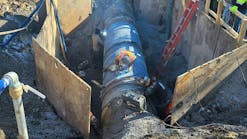WASHINGTON, DC, Dec. 7, 2013 -- According to a new report from the U.S. Department of Agriculture (USDA), the Chesapeake Bay watershed is experiencing a significant reduction in nitrogen, sediment and phosphorus generated from cultivated croplands.
The report, part of USDA's Natural Resources Conservation Service (NRCS) Conservation Effects Assessment Project (CEAP) estimates that since 2006, conservation practices applied by farmers and landowners are reducing nitrogen leaving fields by 48.6 million pounds each year, or 26 percent, and reducing phosphorus by 7.1 million pounds, or 46 percent.
Accordingly, the report further indicates that these practices have also lowered the estimated average edge-of-field losses of sediment, or eroded soil, by about 15.1 million tons a year, or 60 percent -- enough soil to fill 150,000 railcars stretching more than 1,700 miles. The majority of the conservation practices in the Chesapeake Bay were made possible through Farm Bill conservation programs, which are now expired.
"This report demonstrates that voluntary conservation practices made possible through the Farm Bill can have a substantial impact on limiting nutrient and sediment runoff from farms in the Chesapeake Bay Watershed and across the nation," Agriculture Secretary Tom Vilsack said. "These conservation efforts help to clean our soil and water, boost outdoor recreation that adds more than $640 billion to our economy, and ensure that agriculture has the tools to remain productive in the years to come. It is critical that Congress act now to pass a Farm Bill that provides the full array of programs and incentives to build on these efforts."
The Chesapeake Bay watershed touches six states and is home to 17 million people and almost 84,000 farms and ranches. Agriculture contributes about $10 billion annually to the region's economy. Conservation practices have other environmental benefits, such as sequestering carbon and making farms more resilient to extreme weather events linked to climate change. In order to better target conservation efforts in the region, USDA launched the Chesapeake Bay Watershed Initiative (CBWI), in 2008, which purported funding to priority watersheds and practices that would have the biggest impact on watershed health.
Due to these efforts, the report highlights a wider acceptance of innovative conservation practices. Notably, some form of erosion control has been adopted on 97 percent of cropland acres in the Chesapeake Bay Watershed. While this does not mean that all acres are fully treated to address sediment and nutrient losses, it is a positive indication of a willingness by farmers to do their part to help restore the Bay watershed. Additionally, the report shows an increased use of cover crops by Bay watershed farmers. Since 2006, land with cover crops in a cropping system increased from 12 percent of acres to 52 percent. Farmers are using a variety of other conservation practices, such as no-till, that help keep nutrients and sediment on fields and out of nearby waterways.
In October, the Chesapeake Bay Watershed Initiative expired due to the expiration of the 2008 Farm Bill, reducing the technical and financial assistance available to bay watershed producers.
The full report, along with a fact sheet, summary and infographic, is available here. Learn more about USDA's Conservation Effects Assessment Project.
###


